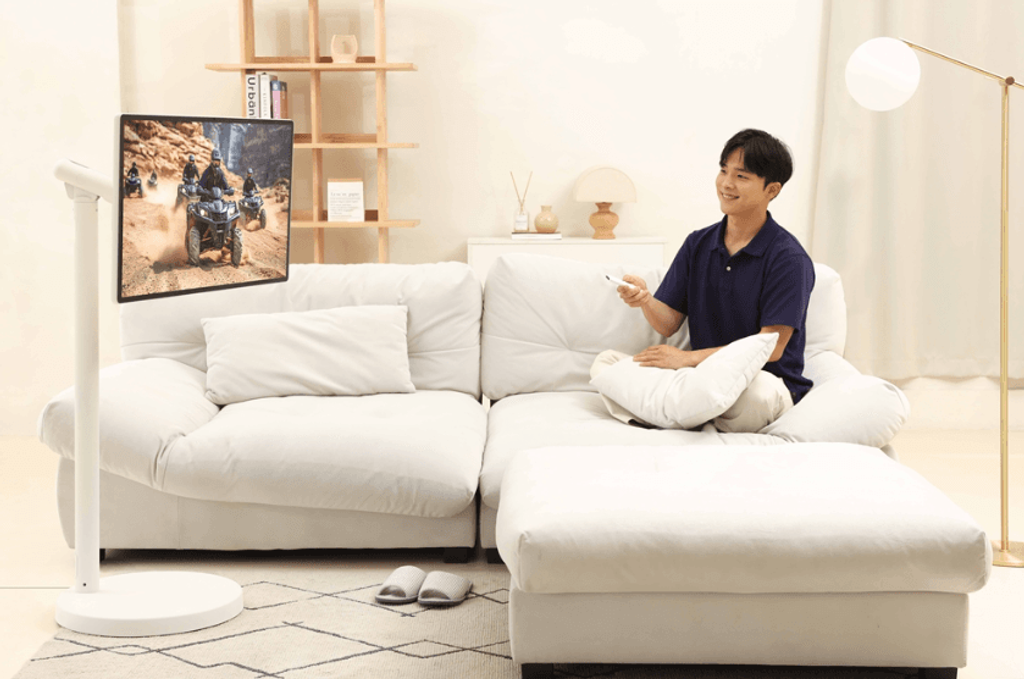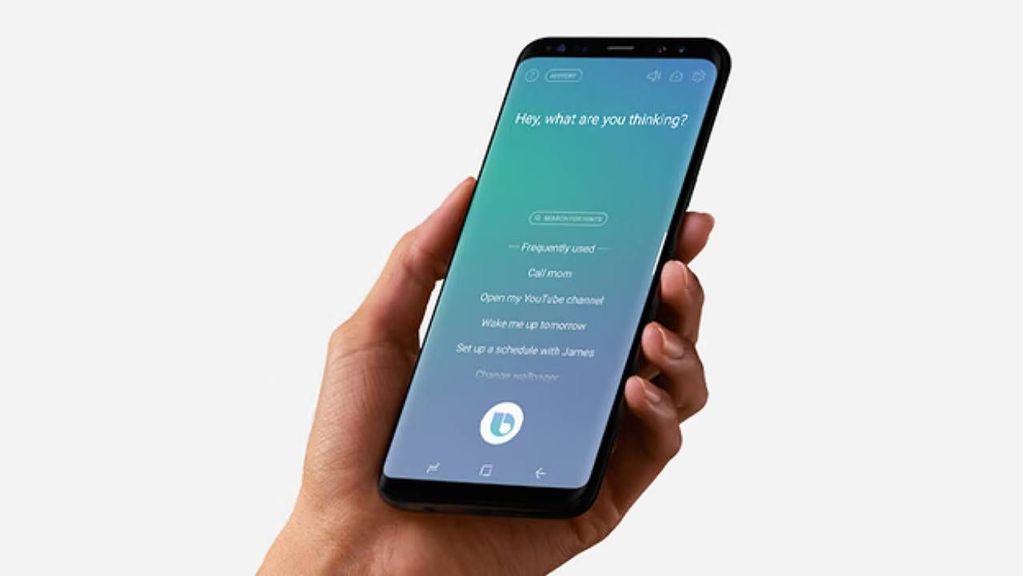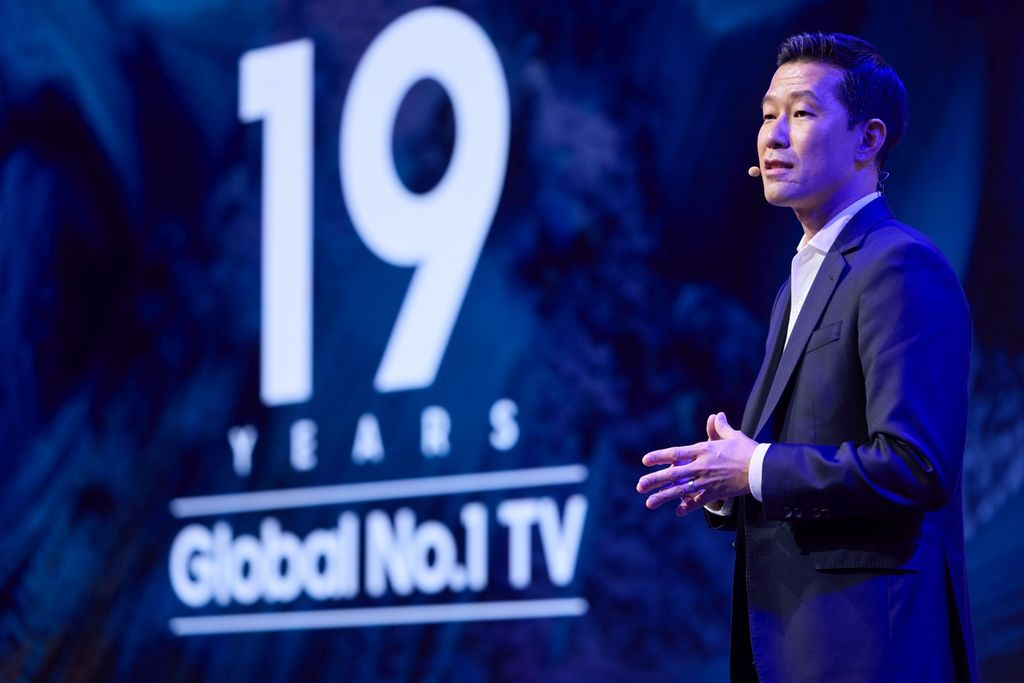- Matching (Score)
- Our verdict
- Competing TVs
- TV appearance
- Where to buy
- Contrast and black detail
- HDR effect quality
- Factory color reproduction
- Color reproduction after calibration
- Smoothness of tonal transitions
- Image scaling and smoothness of tonal transitions
- Blur and motion smoothness
- Console compatibility and gaming features
- Input lag
- Compatibility with PC
- Viewing angles
- Daytime performance
- TV features
- Apps
- Playing files from USB
- Sound
- Panel details
Samsung DU7192 (IPS) Review
DU7192 / DU7172
Available screen sizes:
Diagonal with a different matrix: , , ,

Complete the survey to find out the result
Panel type: LCD IPS Refresh rate: 60Hz Brand: SAMSUNG Resolution: 3840x2160 System: Tizen Model year: 2024
SAMSUNG DU7192 IPS - Our verdict
5.0
Overall rating
The Samsung DU7192 is an affordable option ideal for casual, everyday viewing. It excels during the day, with ambient light helping to mask its less-than-ideal black levels. The IPS panel ensures that colours retain their vibrancy and saturation even when viewed from an angle. With its impressive brightness, the DU7192 is best suited for regular TV viewing or YouTube, but HDR content on streaming platforms may appear too dark to fully enjoy.
One of the TV's standout features is its colour reproduction after calibration, which delivers accurate colours close to the director's intended vision. The quality of tonal transitions is also commendable, placing this model ahead of many in its price range. In terms of functionality, the DU7192 works well with a computer. Thanks to chroma 4:4:4 support, it performs excellently as a monitor, providing clear and sharp text. Additionally, the operating system runs smoothly and efficiently, with no freezing during tests. The built-in player also handles most files without issues.
The Samsung DU7192 is an excellent choice for those with more modest expectations, offering a solid and reliable viewing experience for everyday content. Its modern and sleek design, and matte finish, allow it to seamlessly blend into most living room decors. The TV's slim profile makes it easy to mount on the wall, making it an ideal option for those who value style and space-saving functionality. This TV is perfect for individuals seeking an uncomplicated, minimalist setup with reliable performance.
Advantages
Excellent cooperation with the computer - low input lag, chroma 4:4:4
Faithful color reproduction after calibration
Minimal color degradation at an angle
Smooth operation of the Tizen system
Disadvantages
Low brightness of HDR materials
No tone transition smoothing feature
Average image scaling
Movies and series in UHD quality
4.6
Classic TV, YouTube
4.2
Sports broadcasts (TV and apps)
4.8
Gaming on console
6.4
TV as a computer monitor
6.0
Watching in bright light
2.8
Utility functions
5.5
Apps
8.7
Sound quality
5.4
Complete the survey to find out what fits your preferences
SAMSUNG DU7192 IPS - Competing TVs in this price range
SAMSUNG DU7192 IPS - TV appearance
HDMI inputs: 3 x HDMI 2.0, 0 x HDMI 2.1 Outputs: eARC (HDMI), ARC (HDMI) Network Interfaces: Wi-Fi 2.4GHz, Wi-Fi 5GHz, Ethernet (LAN) 100Mbps
Build quality: Average
Stand type: Legs
Bezel color: Graphite








Stand: Height adjustment
Flat design: No
Accessories: Stand
Buy at the best price
Select size:
SAMSUNG DU7192 IPS - Contrast and black detail
1.6/10
Local dimming function: No

Result
800:1

Result
950:1

Result
900:1

Result
900:1

Result
800:1
Visibility of details in the lights:

The Samsung DU7192 uses an IPS panel, which, while providing good viewing angles, falls short in terms of contrast and black levels. The measured contrast ratio is only 950:1, a result that is notably low and suggests the TV may not perform well in home cinema setups, especially for those seeking deeper blacks and high contrast in their viewing experience. It is important to note that this review is based on the 43" version, and other sizes may feature different panel types, potentially offering better performance.
For panel quality, the Samsung DU7192 sits in the lower category of IPS screens, which can typically deliver much higher contrast ratios. However, considering this is a budget-friendly model, it is designed for simpler use cases, such as a secondary TV or a basic television for seniors who may not require top-tier image quality.
In the first scene from the film Oblivion, the TV displays a navy blue-black shade, with a good separation of light coming from the spotlight. The image can be improved further with zoom for better visibility. While this scene shows no significant issues, the second scene from The Revenant highlights the TV's shortcomings. The lack of contrast results in a flat, depthless image, with noticeable overexposure in the corners—a common flaw in budget models. The TV does provide decent clarity of detail, but this is more of a silver lining amidst generally disappointing results in image quality.
Halo effect and black detail visibility:
SAMSUNG DU7192 IPS - HDR effect quality
3.4/10
Supported formats: HDR10, HDR10+, HLG Color gamut coverage: DCI P3: 82.2%, Bt.2020: 61.2%
Luminance measurements in HDR:

Result
200 nit

Result
228 nit

Result
246 nit

Result
233 nit

Result
245 nit
The maximum luminance for HDR content on the Samsung DU7192 is 245 nits, but is often exceeded by even lower results. Such values are insufficient for comfortable viewing of HDR material due to the lack of appropriate image dynamics and the colour distortions caused by the device's low brightness. While the manufacturer has equipped the device with an HDR format featuring dynamic metadata, specifically HDR10+, it is rarely used compared to Dolby Vision, which Samsung has yet to introduce in its televisions. It is also worth noting that the Samsung DU7192 only covers 82% of the wide colour gamut DCI-P3, meaning that sending signals in a wide dynamic range should be avoided, as significant colour loss will be evident.
Overall, the Samsung DU7192 delivers high-quality images that will satisfy most users. The television stands out particularly for its vivid colours and decent contrast. Thanks to UHD technology, the image on the screen is sharp and clear, even during fast-moving scenes. The DU7192 also supports HDR, allowing for better reproduction of details in bright and dark areas of the image.
Scene from the movie “Pan” (about 2800 nits)

Scene from the movie “Billy Lynn” (about 1100 nits)

While testing the unit with film content, our earlier observations were reflected in the performance. A scene from the film Mr. displayed a severely disrupted tonality, with details blending into whites and significant darkening. It is worth noting that there are units within a similar price range that manage this scene better, thanks to effective dynamic tone mapping. In those cases, the only issue was the darkening of the image, but the tonality itself remained intact, resulting in a more comfortable viewing experience.
Similarly, Billy Lynn's Long Halftime Walk proved to be a difficult film for the DU7192 to display. The first thing noticeable was the low contrast, which led to a lack of image depth. Perhaps less noticeable initially, but more bothersome over time, was the issue with skin tone representation, where significant losses were visible. The main character’s face in certain scenes appeared almost uniform, which certainly did not reflect reality.
HDR luminance chart:
HDR luminance
Even when the television is provided with a signal that includes dynamic metadata, the performance remains unchanged, which is not surprising, given the television's capabilities. As illustrated, the result is a complete blending of details in the whites. Therefore, it can be concluded once again that the Samsung DU7192 does not perform well with HDR content.
Static HDR10

Dynamic: HDR10+

Factory color reproduction
4/10
The best factory mode we used throughout the testing process was "Filmmaker." However, like most modes, it had its drawbacks. Starting with the most basic chart, the white balance, we observed a pronounced dominance of red in SDR and HDR modes. Although green also appeared in HDR mode, it did not significantly affect the overall perception. This resulted in an image with a noticeable yellow tint, particularly evident on the whites and the faces of the actors.
Another important chart, arguably more significant, is gamma, which controls contrast in materials with a standard colour palette. In factory mode it performed reasonably well, but with one notable issue regarding the darkest scenes. Here, it was significantly lowered, resulting in excessive brightening, which robbed the film of its contrast and suspense.
As for HDR content, the white balance remained similar. The main change occurred in the EOTF curve chart. Initially, we saw a bulge that, like the gamma curve, brightened the darkest scenes considerably. However, the curve then drastically changed, and the measured result dropped below the reference line, diminishing the dynamism of the film even further.
Color reproduction after calibration
5.9/10
Samsung even with its entry-level televisions, provides advanced tools for calibration, and we put these to work. The results of our efforts were more than satisfying. The white balance, which previously had a strong yellowish tint in both scenarios, now looks much improved, although slight deviations from the ideal are still noticeable. Nevertheless, the image is significantly cleaner than before the calibration process. We were able to model the gamma well for SDR materials, achieving as much contrast as the television can provide. The EOTF curve has also been adjusted, preventing the image from becoming excessively lightened or darkened. However, it is worth noting that for HDR materials, the deltaE errors remain quite high, with the primary issue being the unit's insufficient brightness.


SAMSUNG DU7192 IPS - Smoothness of tonal transitions
7.7/10
One area where the Samsung DU7192 truly stands out is in its handling of tonal transitions. The TV managed them efficiently, with no noticeable issues in most scenes. The only minor flaw was a slight posterisation in the reds on the left side of the final scene. However, a more significant issue to note, which was not part of this particular testing, is the strong backlight uniformity issues present in the majority of scenes. This becomes more noticeable during evening viewing, potentially detracting from the overall viewing experience.








Image scaling and smoothness of tonal transitions
3.2/10
Smooth transition function
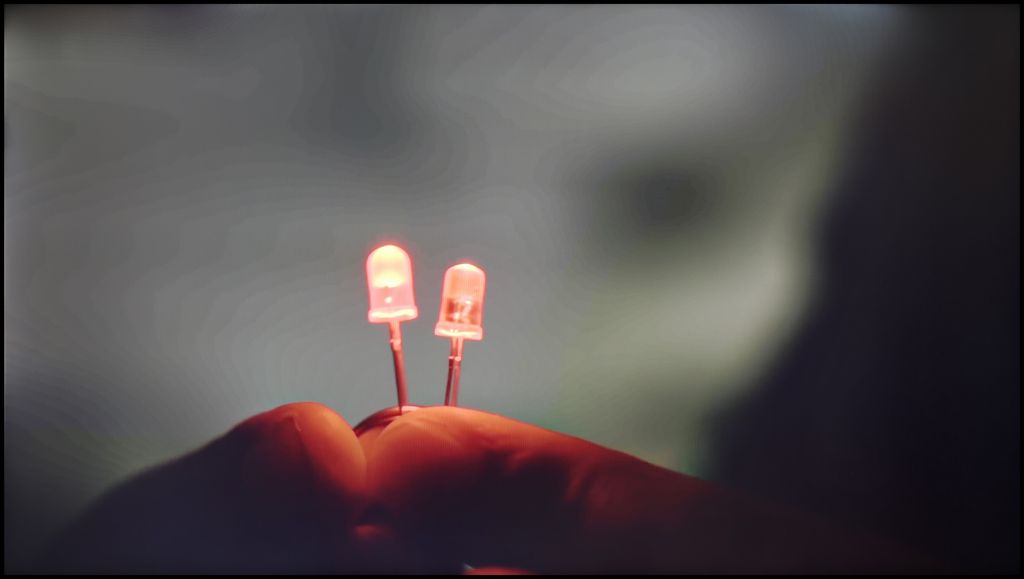
Image without overscan on the SD signal

Let’s revisit the smoothing of tonal transitions function. It can be set to either "off" or "auto." As expected, setting it to "off" results in significant gradation issues. On the other hand, when set to "auto," both movies and TV shows offer smoother colour transitions. However, this function has notable drawbacks: it interferes with the director’s intent by softening the effect of film grain and, more concerning, it often blurs small details, misinterpreting them in the process. For this reason, we consider this feature ineffective and do not recommend using it, as the tests for tonal transition smoothness were conducted with this function turned off.
Next, we assessed the image scaling, which is crucial for watching lower-resolution materials. Unfortunately, as this is one of the manufacturer’s lower-end models, the scaling function does not perform well. The result is heavily blurred details, and a noticeable white halo forms around characters, detracting from the viewing experience.
SAMSUNG DU7192 IPS - Blur and motion smoothness
4.9/10
Maximum refresh rate of the panel: 60Hz
Film motion smoothing option: Yes
Blur reduction option: No
BFI function 60Hz: Yes, 120Hz (double contours)
BFI function 120Hz: No
Brightness drop with BFI: 47%
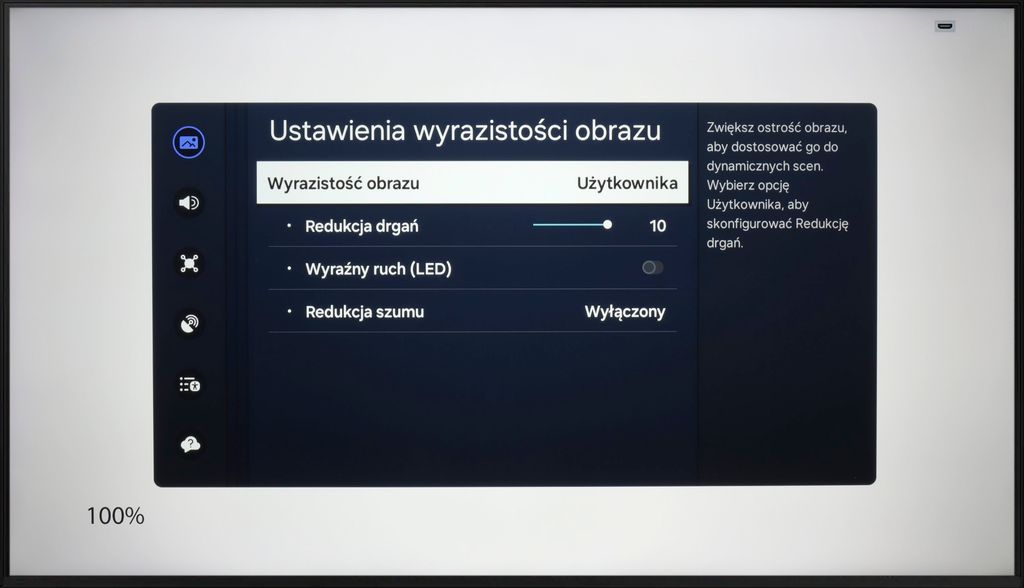
Although the Samsung DU7192 is the entry-level model in the manufacturer’s range, it does come equipped with motion smoothing technology. While this feature is somewhat limited in comparison to higher-end models, its inclusion is a notable advantage in its price category. The maximum refresh rate available on the TV is 60 Hz, which is adequate for movies and TV shows but falls short for fast-moving content like sports.
Within the motion smoothing settings, there are two features aimed at improving fluidity: "Motion Blur Reduction" and "Clear Motion (LED)." We’ll discuss the latter later, but first, let’s focus on the former. Unfortunately, despite being present, we found no noticeable difference when adjusting this setting. Regardless of the chosen option, the picture maintained the same stuttering effect typically associated with 24 fps content.
The Samsung DU7192 uses a panel with an average response time. However, it is worth noting that this type of panel outperforms VA panels in a similar price range, making it a more suitable option for watching sports compared to other budget models.
Blur (native resolution, maximum refresh rate):



In terms of motion fluidity, it’s worth noting the inclusion of BFI (Black Frame Insertion) technology, which involves inserting a black frame between film frames. This technique aims to "reset" the retina, thereby improving the perceived sharpness of the image. However, while the manufacturer implemented this feature, it does not perform particularly well. The result is a noticeable decrease in brightness, and strong flickering, which can detract from the viewing experience rather than enhance it.
SAMSUNG DU7192 IPS - Console compatibility and gaming features
4.2/10
ALLM: Yes
VRR: No
VRR range: No
Dolby Vision Game Mode: No
Correct implementation of HGIG: Yes
1080p@120Hz: No
1440p@120Hz: No
4K@120Hz: No
Game bar: No


The Samsung DU7192 is equipped only with HDMI 2.0 ports, which is to be expected given the device's price point and its target consumer market. As a result, it does not support the highest resolutions or frame rates available on the latest generation consoles. It does, however, feature the basic gaming functionality of ALLM (Auto Low Latency Mode). Unfortunately, it is disappointing that the manufacturer did not include GameBar, a feature that has become a standard even in lower-end TVs. GameBar would have provided significant convenience by allowing gamers to easily adjust settings quickly during gameplay.



SAMSUNG DU7192 IPS - Input lag
10/10
The input lag measurements on the Samsung DU7192 are impressive, offering excellent performance regardless of the signal or resolution. Gamers will certainly appreciate the manufacturer's efforts to ensure that a game running at 4K 60 Hz with HDR only experiences 11 ms of latency. This level of input lag is practically unnoticeable, even in fast-paced online games, making it a solid choice for gaming despite the TV's entry-level position.
| SDR | HDR | Dolby Vision |
|---|---|---|
| 1080p60: 11 ms | 2160p60: 11 ms | |
| 2160p60: 11 ms |

SAMSUNG DU7192 IPS - Compatibility with PC
6/10
Chroma 444 (maximum resolution and refresh rate): Yes
Font clarity: Very Good
Readability of dark text and shapes: Very Good
Input lag in PC mode (4K, maximum refresh rate): 11ms
Matrix subpixel arrangement: BGR
Max refresh rate: 60Hz
G-Sync: No
When connecting the Samsung DU7192 to a computer for use as a monitor, users can benefit from an impressively low input lag of just 11 ms, which is virtually imperceptible along the mouse-screen-eye line. The TV’s accurate implementation of chroma 4:4:4 ensures high readability of fonts, making it suitable for tasks involving text work. The IPS panel contributes further to this suitability by providing inherently sharp text due to its design.
The subpixel arrangement on the DU7192 is BGR, which, while differing from the standard RGB, does not negatively impact its use as a monitor. Although operating systems are typically optimised for the RGB format, which could lead to slightly less defined contours, this is a minor issue that only a few discerning users might notice. Overall, the TV performs well when connected to a computer for general monitor use.
SAMSUNG DU7192 IPS - Viewing angles
6.8/10
Brightness drop at an angle of 45 degrees: 64%
Unlike VA panels, IPS panels are renowned for their excellent viewing angles, and the same holds for the Samsung DU7192. Even when viewing from a slight angle off-centre, colours maintain their hue and saturation effectively. However, it is important to be aware of the typical drawback of IPS technology: a noticeable drop in contrast when viewed from an angle, a common limitation for LCD panels.
SAMSUNG DU7192 IPS - Daytime performance
2.8/10


Panel finish: Satin
Reflection suppression: Poor
Black levels during daytime: Average
The Samsung DU7192 panel features a satin finish, which unfortunately does little to mitigate reflections from direct light sources. This issue is further compounded by the panel's maximum brightness of 227 nits in SDR mode. Consequently, it can be concluded that this television is not particularly well-suited for daytime viewing, where higher brightness levels are essential for optimal visibility.
Panel brightness
Average luminance SDR
Samsung DU7192 (IPS): 227 cd/m2
SAMSUNG DU7192 IPS - TV features
5.5/10
System: Tizen
System performance: Decent
- HDMI inputs: 3 x HDMI 2.0, 0 x HDMI 2.1
- Outputs: eARC (HDMI), ARC (HDMI)
- Network Interfaces: Wi-Fi 2.4GHz, Wi-Fi 5GHz, Ethernet (LAN) 100Mbps
- TV reception: DVB-T, DVB-T2, DVB-S, DVB-S2, DVB-C
Classic features:
Recording to USB (terrestrial TV): No
Recording programming: No
Picture in Picture (PiP): No
RF remote control (no need to aim at the screen): Infrared
Backlit remote control: No
Teletext: Yes
Audio only mode: Yes
Bluetooth headphones support: Yes
Simultaneous Bluetooth headphones & TV audio: Yes
Smart features:
AirPlay: Yes
Screen mirroring (Windows Miracast): Yes
Voice search: No
Voice search in native language: No
Ability to connect a keyboard and mouse: Yes




The Samsung DU7192 operates on the proprietary Tizen system, a well-established platform that Samsung has refined over the years. One of its key strengths is smooth and reliable performance, with minimal stuttering, as confirmed by our tests. However, the system's primary drawback is its closed nature. Despite a fairly comprehensive app store, users remain dependent on the manufacturer for software updates and availability. This means that installing apps from external sources, such as a USB drive, is not possible.
On the positive side, Tizen integrates features that are beneficial for Apple users, such as AirPlay, enabling seamless screen mirroring to the television. Samsung has also added support for connecting a keyboard and mouse, facilitating faster and more efficient menu navigation. Another welcome addition is the Bluetooth-connected remote control, which, in previous models, was often absent.
Tizen's integration with external devices, including NC+ decoders and soundbars, is another highlight, as the connection process is straightforward and user-friendly. Overall, while advanced users might lament the lack of customisable options like KODI, most will find the Tizen system to be a smooth, dependable software solution that enhances the television experience.
Sound connection options
HDMI audio:
Other audio outputs:
Wireless audio:
Bluetooth: Yes
Supported audio formats (external HDMI eARC audio):
Dolby Digital Plus 7.1: Yes
Dolby True HD 7.1: No
Dolby Atmos in Dolby Digital Plus (JOC): Yes
Dolby Atmos in Dolby True HD: No
DTS:X in DTS-HD MA: No
DTS-HD Master Audio: No
Senior accessibility
Numeric keyboard on TV: No
Font size adjustment: Yes
Audio description: Yes
SAMSUNG DU7192 IPS - Apps
8.7/10























SAMSUNG DU7192 IPS - Playing files from USB
9.1/10

| Maximum photo resolution: | Supported photo formats: |
|---|---|
The built-in player of the Samsung DU7192 is a notable advantage. It managed to handle nearly all video and audio files prepared for testing with impressive efficiency. Unsurprisingly, the main exceptions were the Dolby Vision format and certain less common codecs. Additionally, the player supports Polish characters and allows users to change font colours, adding a touch of customisation.
However, the player’s performance is less robust for image formats, as it only supports the widely-used JPEG format. The absence of support for other formats, such as PNG or Apple's HEIC, is noticeable and limits the range of image files that can be displayed.
SAMSUNG DU7192 IPS - Sound
5.4/10
83dB
Maximum volume
Supported codecs
(TV speakers)
Dolby Digital Plus 7.1
Dolby True HD 7.1
Dolby Atmos in Dolby Digital Plus (JOC)
Dolby Atmos in Dolby True HD
DTS:X in DTS-HD MA
DTS-HD Master Audio
When evaluating the sound performance of the Samsung DU7192, it is important to note that its built-in speakers are not particularly impressive. This results in generally poor sound quality, with noticeable limitations. We recommend keeping the volume at or below half of the scale to avoid distortion.
On the positive side, the television supports a comprehensive range of audio codecs, including the essential DTS-HD Master Audio and Dolby Digital Plus. These codecs enable the transmission of surround sound to external devices, ensuring high-quality audio for users who prefer enhanced listening experiences through additional audio equipment.
Acoustic Measurements
No acoustic data
SAMSUNG DU7192 IPS - Panel details
Software version during testing: T-KSU2EDDEUC-1043.3
Image processor: -
Subpixel Structure:

Panel uniformity and thermal imaging:
Backlight Type: White LED

Founder and originator of the "ChooseTV" portal

Journalist, reviewer, and columnist for the "ChooseTV" portal
See articles related to Samsung DU7192 (IPS):
2/15/2025
1/16/2025




